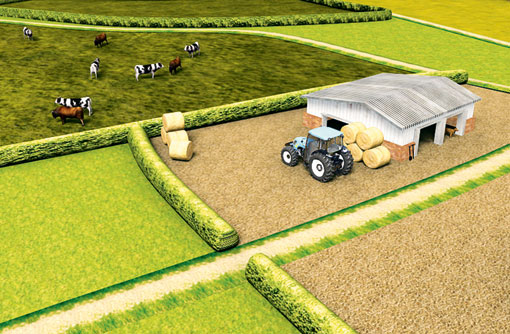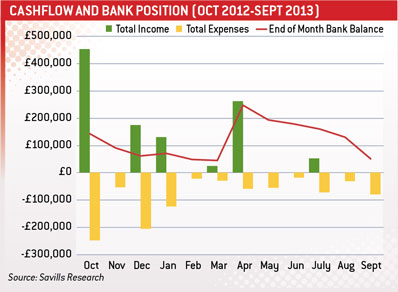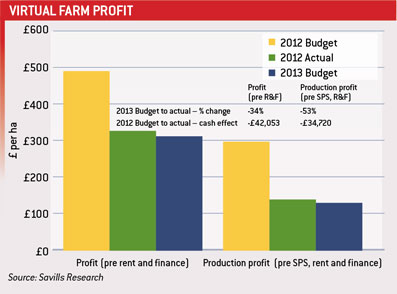Virtual Farm: Weather knocks budget and cropping plans

First wheat cost of production rose by 26% to £150/t on the Farmers Weekly/Savills Virtual Farm in 2012.
The increase was mainly due to a 19% drop in yield, although higher fungicide use is also reflected in the higher production cost per tonne.
“We spent more trying to protect what we had,” says Andrew Wraith, head of agribusiness at Savills. “The later-drilled second wheats often performed better than the first wheats, which we would have expected to be the bankers.
The effect of lower yields and deductions on profit is dramatic – a 34% drop in budgeted profit, pre rent and finance, to £364/ha. The position before SFP, rent and finance is a 53% drop in what was expected, to £158/ha.
WHAT IS THE VIRTUAL FARM?
- The Virtual Farm is a top 25% arable producer, an efficient, well-run business but facing depreciation and investment issues
- Created by Savills Agribusiness and Farmers Weekly to identify challenges for similar businesses and design strategies to cope with them
- Farm model is hypothetical family partnership
- Budgeted figures based on Savills’ client base, model allows scenarios to be tested
- Three-quarters owner-occupied, one-quarter FBT
- Traditional and modern farm buildings
- Cultivations and machinery centred on non-inversion tillage system
- Core borrowing on a long-term loan, plus overdraft
“If there are people out there saying they can do without SFP, they can have my bank details,” said Mr Wraith.
Yields on oilseed rape and beans also dropped, by 13% in both crops. Marketing was a challenge, too – the wheat yield drop meant that instead of 25% of grain moving in September-December, 50% had actually been committed for that period. The Virtual Farm’s normal marketing plan sees wheat leaving the farm in equal quarterly batches from 1 September.
Harvest impact on Virtual Farm
- Budget of £140/t ex farm price
- Sales averaged £156.75/t ex farm after deductions
- Average specific weight deduction of £12.50/t
Careful management and segregation of grain, including blending, has been important in minimising claims and selecting appropriate markets.
Farms which had limited their forward sales benefited not only from higher prices but from not having oversold grain.
However Mr Wraith questions whether this is a good strategy in a volatile market.
“It’s never wrong to take some profit based on a sensible budgeted yield and cost – I would still stick to the plan but we will probably scale back to selling about 20% for the September to December quarter.”
FARM FACTS
- 830ha arable farm model
- 810ha cropping
- 16ha scattered woodland parcels
- 4ha hardstanding and tracks
5-year average yields
- First wheat 8.7t/ha
- Winter oilseed rape 3.7t/ha
Rotation
- Feed wheat (48% of cropped area)
- Winter oilseed rape (34%)
- Spring beans (15%)
- Entry Level Stewardship (3%)
Family owner-occupied farm
- 1 x paid manager
- 1 x full-time general farmworker
- Some casual labour when necessary
Machinery
- 1 x 300hp tractor (eg Challenger, on or off tracks)
- 1 x 175hp tractor (main drill tractor)
- 1 x 135hp tractor + 1 x 135hp tractor (hired when needed, eg harvest)
- 1 x 350hp combine harvester (eg Claas Lexion 570, owned)
- 1 x telehandler
- Mix of new and well-depreciated machinery. Tractor life expectancy 7-8yrs
Looking ahead to this year’s crop, 2013 already has its casualties – 171ha of oilseed rape has failed and this land will be fallowed, allowing an early entry for 2014 first wheat and some tidying up where necessary on blackgrass, drains and ditches.
A cover crop might be possible, depending on conditions.
Just over 78ha of winter wheat will have to be redrilled with spring wheat, although the ability to do this across the whole area is questionable.
“It’s now the end of January and our plans are in flux – although the aim is to replace it with spring wheat, we may have to fallow some of the heavier wheat land too – it could all end up fallow.”
Considerations include the extra variable costs for spring crops when there is probably winter seed in store and paid for.
Yield expectations for the Virtual Farm have been reined back to lower than the 2012 crop results for wheat and oilseed rape.
“We’re looking a bit harder at heavy Grade 3 land across the arable land we advise on,” said Mr Wraith.
Farms that rely heavily on contractors will benefit in 2013 from not having the fixed costs burden which the Virtual Farm carries by owning all its own machinery, points out Mr Wraith.
“We will be saving a bit on fuel and a little on wearing parts if the fallow land is not touched but we will still have the fixed costs of owning our own machinery.”
Virtual Farm – 2013 cropping
- First wheat 236ha @ budget yield 7.9t/ha
- Second wheat 157ha @ budget yield 6.4t/ha
- Oilseed rape 166ha @ budget yield 2.5t/ha
- Spring beans 79ha @ budget yield 3.7t/ha
- Spring wheat 79ha @ budget yield 4.9t/ha
While the position on the Virtual Farm reflects that across many holdings on which the Savills agribusiness team advises, Mr Wraith stresses the vast spread of performance by farm and region this year. Arable production costs are unlikely to reduce this year despite fertiliser being cheaper, depending on when it was bought.
“The impact of the 2012 and 2013 seasons will be very unit specific and so will the reaction of banks,” he says.
“Performance has been in a wider range than we have ever experienced and there will be some arable farms that will have done very well indeed in 2012 and are looking good for 2013 at this stage. On the other hand we know of 400ha arable farms where not an acre has been drilled yet.”
Looking ahead, the Virtual Farm like many others will need to consider whether the focus on machinery investment should continue, says Mr Wraith.
“Should we maybe be looking at improvements to land or other infrastructure? The last season has brought into sharp focus the lack of investment in drainage on many farms since the improvement schemes of the 1980s, for example.”
A capital expenditure holiday could also be argued for, but efficiency needs to be maintained, says Mr Wraith.
Wheat prices in the 2013 harvest Virtual Farm budget are at £180, £185, £188 and £190t across the four marketing periods from September to the end of August.


Although grain prices have been high for months, a price drop remains a real risk and like all businesses, the Virtual Farm has to protect itself against this.
The farm has not sold any 2013 crop grain yet. “But with ex-farm prices at £180-185/t for harvest, I expect we’ll be making a commitment soon on some of the first-quarter grain,” said Mr Wraith.
After the experience of the 2012 crop when the yield drop meant that a far larger proportion of grain was committed than planned, the plan this year is to sell just 20% for September to December movement, rather than the more usual 25%.
The farm has not hedged its SFP in the past but may well look at this in 2013, considering either its bank or a currency broker for this service.
The Virtual Farm has FBT rent at a “manageable” £309/ha but a rent review is expected this year.
Management issues for 2013 on the Virtual Farm and across many other units include mitigating cashflow problems, with early identification of pinch points and good communication with banks essential.
Consideration could be given to increasing the use of trade credit to help fund input purchases.
There may also be opportunities to reschedule HP payments, but this should not be a first option as it could involve financial penalties, warns Mr Wraith.
Hiring rather than buying machinery was another route to consider in a difficult year, as was any reasonable potential to cash in suitable assets to bring the proceeds into the business.
